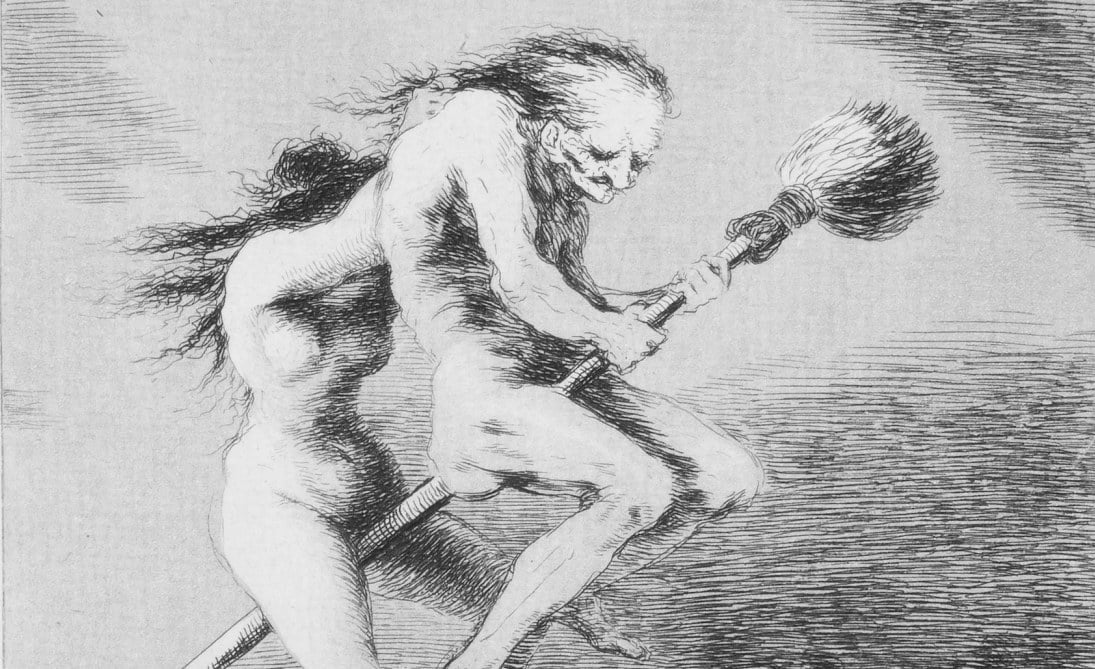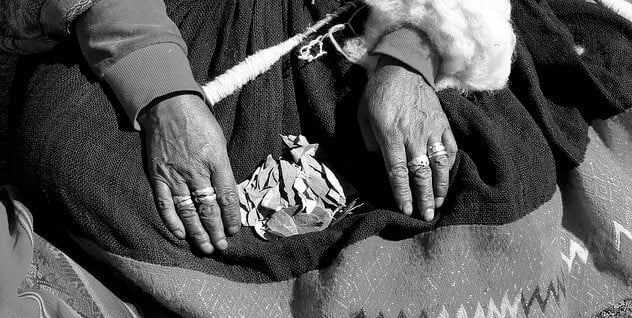Myths and legends from Chiloé possess a multitude of creatures and a distinct and interesting history of male witches, Francisco Goya’s painting of witches did much to shape perceptions of sorcery in Spanish- speaking societies in the late 18th and early 19th centuries.
Part of the attraction of Chiloé is the wealth of mystery that permeate the misty, foggy reaches of forest and remote beaches, where creatures and male witches dwell.
In this Article
Chiloé is traditional art, elaborate folklore, myths and legends. Green rolling hills with a rugged yet enchanting coastline; independent people; rain- and potatoes.
Potatoes?
Biologists from the Chilean University Austral have identified approximately 420 different varieties of potatoes on the archipelago. Solanum tuberosum tuberosum, one of the world’s most cultivated and popular potato varieties, has been identified as a native species of Chiloé. A meal without “potato- would be unimaginable” for Chilotes.
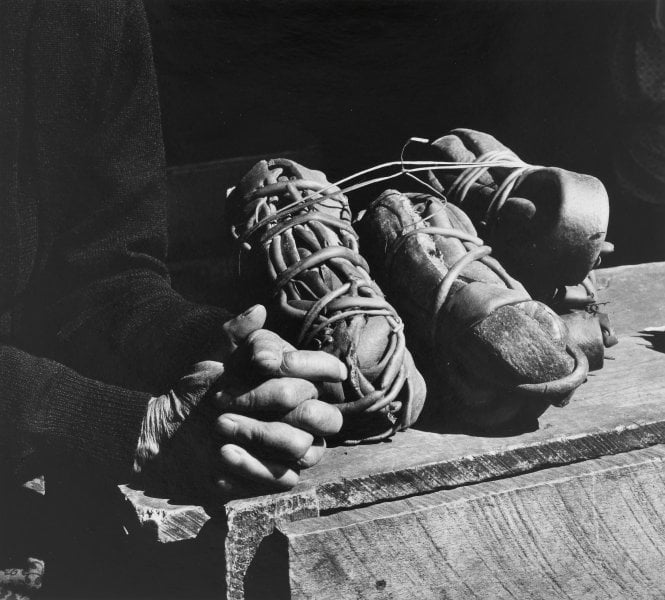
In addition to being potato growers, active fishers and shellfish gatherers, I watch Chilotes knee-deep in the seas collecting seaweeds. The Chonos, a nomadic seafaring tribe, and the Huilliche (part of the Mapuche population), who settled here from the mainland – indigenous people have long since valued seaweeds as both food and medicine.
In her book, My Invented Country, Isabel Allende describes Chiloé as having a
“culture different from the rest of the country…Chilotes live as they did a hundred years ago, dedicated to agriculture and the fishing industry…Buildings are constructed solely of wood, and in the heart of each house there is always a huge wood stove burning day and night.”
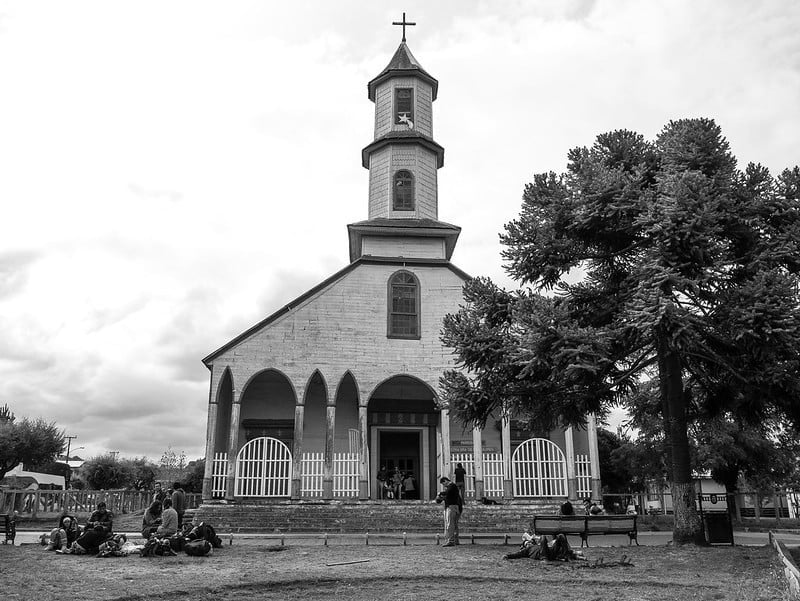
The architecture on Chiloé is renowned for its unique blend of traditional Chiloé carpentry with Spanish Baroque, neo-classical and neo-gothic styles. Sixteen churches on the island are National Historical Monuments; these are also included among UNESCO’s World Heritage sites. Describing the distinctive nature of these wooden churches as follows:
“They embody the intangible richness of the Chiloé Archipelago, and bear witness to a successful fusion of indigenous and European culture, the full integration of its architecture in the landscape and environment, as well as to the spiritual values of the communities”.
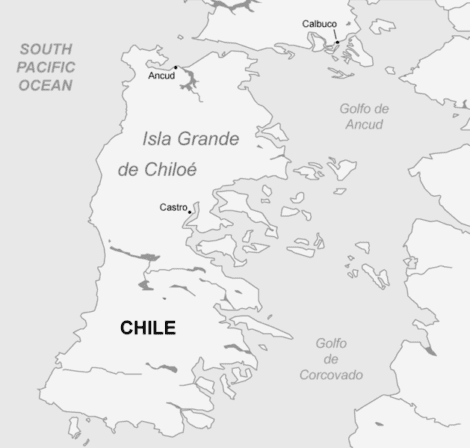
The journey from Puerto Montt on the Chilean mainland to the island of Chiloé takes 40 minutes, the archipelago stretches between parallels 41° and 44° south latitude and down to Tierra del Fuego, the “land of fire” so accurately described by Lucas Bridges as
“the uttermost part of the earth.”
The sea down here in the south is rough, cool wind is blowing around the little shack on the ferry. We buy hot coffee to warm up. Most people are workers, a few travellers, all in heavy pullovers, jackets and warm boots.
When Charles Darwin ventured to Chiloé aboard the HMS Beagle in the 1830’s, he wrote:
“In winter the climate is detestable, and in summer it is only a little better.
The winds are very boisterous, and the sky almost always clouded: to have a week of fine weather is something wonderful.”
The low, fast moving tide rushes into bays where brightly colored houses stand on stilts, recedes as if regularly spooked by the land. When storms roll across the island with electrifying charge and splash rainbows across the sky in their wake, the display of weather is so typical that grazing farm animals barely run for cover.
No sense trying to stall the island’s mystical charm from soaking in. Lichen carpets spindly trees under the cover of a stubborn silver mist. Mist covers the hills, lakes, villages and dense forests. Forests, in which the Trauco for a long time has driven its mischief.
Myths and Legends from Chiloé
THE TRAUCO

He is the seducer of virgins, an ugly, misshapen dwarf, equipped with a stone ax. Spirit of fruitful love, creator of new life and father of all nature children Chiloés. For centuries, he was blamed when young girls suddenly became pregnant. In the 1960s there was the last ‘Trauco’ process. Someone accused the Trauco of having impregnated his daughter. The case even went to court, in the end it came out that it was the father himself…
Trauco lives in the woods near the Chilote people. The strong short man carries a stone axe in his right hand, which he replaces with a staff when he is faced with a girl. He wears a hat made of dried grass and a poncho and doesn’t have feet, only stumps. People say he is the living representation of fecund love -the creator of new life.
Married woman are newer attacked. Not only the girls worry about him, but also mothers, who know the consequences of his mischievous behavior. They avoid sending their girls into the forest in search of firewood or in search of grass for the sheep because he can catch them on their way or give a blow to them with his wooden staff called “pahueldún”. These attacks do not happen if they are accompanied by their youngest siblings.
He prefers to act when he sees girls alone in the forest
To get to know his victims, he disguises himself as a bunch of quilineja [dried sticks used to make brooms] and sneaks into the kitchen, where all the family get together in the evenings. If someone tries to catch him, he disappears in the shadows.
Trauco is always on the alert, hanging from a tree and lurking in the forest for his victims –attractive girls. Whenever he sees a girl in the woods, he climbs down from his tree and he hits the trunk with his axe three times. The echo sounds as if he were chopping trees. As a result of this, the girl gets so confused and scared that she does not realize when Trauco is next to her. Then he hits the girl with his wooden staff and she stares at him, within seconds, she falls into a deep sleep. After some minutes, or perhaps hours (she does not know), she wakes up angry and crying, she stands up, arranges her torn clothes and hair, and cleans the leaves off her back.
Then she runs home through the fields. As time goes by, the girl’s body (possessed by Trauco) starts to change. The girls never hide these changes since they feel they are the victims of a supernatural being, against whom no single woman is protected enough. After nine months, Trauco’s son is born. However, this does not socially affect the mother or the child because they feel linked to the magic of an unworldly being. People conjure a charm on him to keep him away or to escape from the effects of his presence. However, he is so powerful that nothing or nobody can stop him…
Anyway in the night everyone is safe from the Trauco, as soon as it gets dark, he returns home to be with his bad-tempered and feared wife – Fiura.
THE FIURA
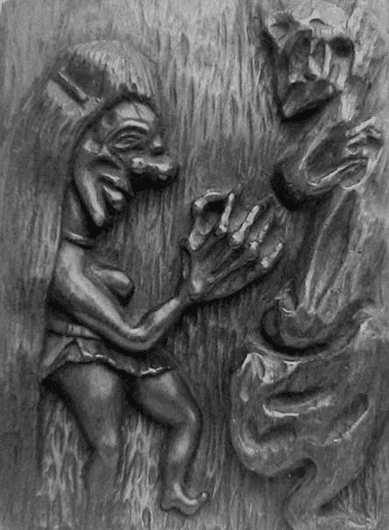
People, especially men,
are careful about Fiura because she is mean and extremely dangerous.
Physically, Fiura is a short woman with long, black hair who always wears a red dress. She is extremely ugly, but this does not stop her from being able to attract men with her harmonious voice and her magical breath.
The Fiura is La Condená’s daughter and Trauco’s wife, although she likes to be with other men as well on the condition that they do not look at her. If they do, then she casts a spell that leaves them ‘twisted’ in some part of their bodies. The name of this spell is “tullir”, – meaning deforming the body.
When she is really angry, she can curse anyone or anything, including children or animals, such as cats, dogs or pigs, or entire families. She can throw these spells from a great distance and they are usually known as ‘airs’ (‘aires’).
Finally, if someone encounters this lady in the woods, it is no good fighting her because it is an impossible task. She possesses incredible force, and is skilled in fighting so that whoever wants to fight with her ends up hurt and wounded, whereas she escapes without a scratch. They say “it is like hitting a shadow”.
As she lives in the marshes of the Chilote woods, and she bathes under the waterfalls, it is a good idea for people to avoid going to those places so they do not come across this dangerous woman.
ON THE ORIGINS OF CHILOE: CAI CAI VILU AND TEN TEN VILU
For the people of Chiloé, it is almost impossible not to associate the earthquakes that sometimes cause a tsunami, or are accompanied by swells with high waves, with the old foundational story of the battle between Ten-ten Vilú and Cai-cai Vilú, the serpents of the land and the water, respectively.
José Santos Lincomán, in his story “Cómo se dividió Chiloé”- cuento muy antiguo de los huilliches, How Chiloé was divided- a very old story of the huilliches, tells a not well known version of the original classical battle between land and sea- Ten-ten Vilú versus Cai-cai Vilú.
A great earthquake takes place; the sea increases its level to the extent that it covers the land. At the end, calmness makes its room in the situation and a man remains with his family in an island, without food, “and started to starve and die from cold”.
MYTH: The Creation of Chiloé
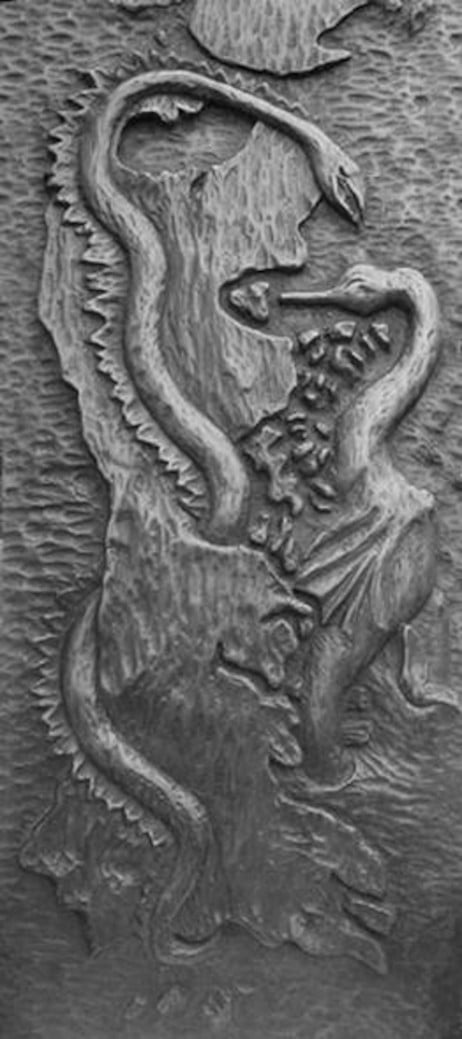
This story has an allegory to sacrifice: in order to restore a destroyed order a human sacrifice is necessary; in this case, a father gives his child in order to appease the sea.
In the beginning, the most powerful spirits of the world were The Pillanes, Peripillán and Antu.
Each of them had a son, but their sons were not so good. For that reason, Peripillán and Antu punished them by turning them into giant snakes.
Peripillán’s son became Cai Cai Vilú (or Coi Coi Vilú, from ‘Coi’ = water, and ‘Vilu’ = snake), and
Antu’s son became Ten Ten Vilú (or Tren Tren Vilú, from ‘Ten’ = earth, and ‘Vilú’ = snake).
The Pillanes sent Cai Cai to be master of the sea and to take care of life in the ocean and sent Ten Ten to be master of the Earth, fire and volcanoes, and to help human beings.
Everybody knew that the two snakes were adversaries.
One day, Cai Cai woke up from his sleep and found out that human beings were very ungrateful for all the things that the sea gave them. This made him extremely angry so, using his fish tail, he hit the water with great force causing a cataclysm, tsunamis and a deluge. The water began to flood all the land in order to punish humans and take them to the bottom of the sea. Everybody was scared and tried to escape from the flood.
When Ten Ten saw all the desperate animals and humans who were calling for his help, he decided to help them. He remembered that his father told him to protect all living forms.
Thus Ten Ten helped all the inhabitants of his land to escape by taking them on his back and bringing them to the top of the hills. Some people, however, could not escape and stayed in the water. Ten Ten turned them into birds so they could escape by flying away.
Cai Cai was still angry, so he commanded the sea to keep rising in order to drown the people and the animals on earth. As the level of the water kept going up and up, Ten Ten ordered the hills to grow bigger and bigger in order to counteract Cai Cai’s power and to provide humans with refuge.
But this only made Cai Cai angrier and he started to attack Ten Ten in a titanic fight that lasted for a long time. Finally, the two giant snakes got tired, which meant that Ten Ten had a partial victory over Cai Cai because the land was not completely covered with water. However, the sea did not go back to its previous level.
This is how the islands of Chiloé was created. The archipelago itself would be a consequence of this endless battle, with occasional truces, and furious violent encounters that, from time to time, change the landscape of the islands. While Ten-ten defends humans by raising the lands for its inhabitants not to drown in the furious waters of Cai-cai, this last one is determined to cover everything with the sea every time it can.
In the end, Cai Cai retired and left Millalobo or Millalonco and other beings in charge of the ocean. The humans who did not make it to the hills became fish, marine mammals or mythical creatures.
Mythical creatures of Chiloé
The mythical creatures of Chiloé are often water suitable half fish and half animal, in every conceivable variants: horses, pigs, chickens, dogs, cats … So the Basilisco is a mixture of bird and reptile. He hides under the houses and sucks the lives from the people who live there, taking their breath away until they finally die. The only way to get rid of him is to burn the house down.
“Do you believe in these myths?” She can not really answer that, says the breakfast lady in the hostel. “They are just part of our everyday lives, enriching our lives, I just know they exist, and I want them to exist.”
There are various mythical creatures in Chiloé, like the Viura – the goddess of perversion and vice, the maniacal Sirena, the chicken-looped Cuchivilu, half pig, half snake and the unicorn Camahueto.
CAMAHUETO

Every twenty five years in Chiloé Island, a Camahueto is born in the depths of the earth under a hill next to the ocean. It looks like a green calf with one little horn on its head. It resembles a unicorn.
After birth, it goes down the hill towards the ocean with such strength and noise that it leaves a trench where a stream flows. The water washes away trees, stones and earth. In the ocean, the Camahueto grows and becomes an adult, living in the sea for the rest of its existence. People say that Camahuetos go to the sea because they are a marine species and that their short stay on earth represents a form of vengeance of Cai Cai Vilú to endlessly continue its destructive work on earth.
The mythical beast began its life underground living near the sea. It grew for many years before bursting through the ground, racing towards the shore, devastating the landscape but creating the rivers, valleys and cliffs, changing the landscape of the archipelago to how we see it today.
From the moment a Camahueto is born to the moment it gets to the sea, a shaman lurks on the beach waiting for it. He knows the exact day and time when a new Camahueto will come to the ocean. As soon as he sees it coming, he lassoes it, cuts off its horn and let it continue his way into the sea.
The Use of Camahueto’s horn:
A Camahueto’s horn is the most valuable thing this creature possesses. The shamans of Chiloé sow small pieces of the horn in other hills and lands and, after twenty five years, other camahuetos are born. But the Shamans take most of the horn home and sell the scrapings of it at a good price either as a piece of paper or as ointment. These scrapings are the most powerful of all medications and constitute the earliest forms of medicine on the Island. They can cure all kinds of illnesses such as anaemia, skin infections, rheumatism, etc.
Before selling the horn scrapings, the shamans boil the substance to prevent people from breeding one of these creatures inside their bodies after absorbing it.
There is also another benefit of this horn: the person who manages to have one of these marvelous horns has great fortune that ensures wealth for the future. All these wonderful properties make the horn an invaluable and highly desirable object.
However, if someone wants to take the horn to another land or province, he or she has to keep it in a container with toasted flour. In that way, A Camahueto cannot smell it and does not know that they are taking away its horn. If the creature suspects someone of doing this, it may result in a dangerous situation for the people.
According to a Chilote story, there was once a motorboat coming from Cucao to Puerto Montt and one of the passengers was secretly carrying a Camahueto horn when suddenly a storm started and the boat almost sank. A wise old man from the Island on board warned:
“There is a person here who is carrying something magically dangerous for all of us. If so, you’d better throw it into the sea”.
The woman carrying the horn followed the man’s words and got rid of it. At that very moment, the storm stopped.
THE PINCOYA
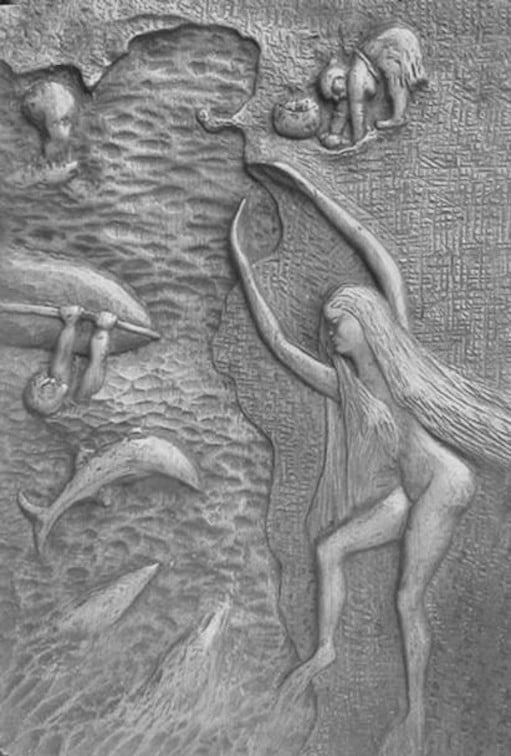
Huenchula, Pincoya’s mother, asked her parents to babysit her little daughter and left her sleeping in a basket in the shape of a seashell. Mortals were forbidden to look at the baby. But Huenchula’s parents were so curious about seeing the little girl that, after looking at her, the baby suddenly turned into water.
When Huenchula returned home, she realized what had happened and cried desperately. She took the basket and poured its contents into the sea. Then Huenchula waded in the sea towards the depths of the ocean in search of her husband, Millalobo. He asked her: “what happened?”, and she told him the story. When she finished the last word of the story, she saw a boat shaped like a seashell, which was carrying her daughter inside. She was now a beautiful young woman. Huenchula named her sweet daughter Pincoya. Pincoya “sows” the variety of fish and shellfish that Millalobo generously offers the Chilote people.
From those times until now, this beautiful blond long haired girl comes out of the sea in a dress made of seaweed and dances on the beach. If she faces the sea when she dances, it means that fishing will be good, that there will be plenty of fish and shellfish on that beach. If she faces land instead, the fishing season will be bad. In this case, people will have to go farther out to sea or to other beaches.
However, when scarcity lasts for a long time due to the absence of Pincoya, fishermen can call her back and she brings abundance after a ceremony.
“If she returns to the sea, there will be plenty of fish. But if she turns to the mountains, there will be a bad catch.”
A grumpy fisherman tells me seriously.
When the tide comes, a lot of foam forms. Biologically, that means the marine animals are reproducing. Then you should not fish.
People in the countryside say, if you do, then the Pincoya, the sea goddess, will be angry.
“So the whole thing has a biological meaning, a doctrine for the protection of nature,”
the young fisherman tells us.
When the Chilote people – who are eternal sea wanderers – sink, they find the untainted and beautiful Pincoya who quickly helps them resume their voyage in safety and protection through the fjords and channels of the archipelago of Chiloé.
If, for any reason, she can’t save them, she gently carries the dead bodies of the fishermen to a ghost ship – the Caleuche. To do this, she gets help from her siblings: La Sirena (the mermaid) and Pincoy. On board The Caleuche, the fishermen live as part of the crew of this ghost ship and have a new life with eternal happiness.
Perhaps, this is why Chilote people are not afraid of storms at sea, even if they do not know how to swim. Pincoya’s spirit, which always cares about them, gives them courage to risk their lives at sea when fishing in different parts of the archipelago.
THE MALE WITCHES OF CHILOÉ
The Incas thought, close to 35th parallel lay a land of mystery and darkness. It was a place where the Pacific’s waters chilled and turned from blue to black, and it was also where the witches lived and evil came from. They called this land “the Place of Seagulls”and in the first years of the 16th century it marked the spot at which the Empire of the Incas ended and a strange and unknown world began.
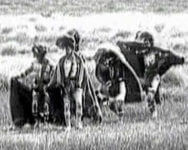
A photo, on the right, sometimes said to depict members of Chiloé’s murderous society of warlocks—founded, so they claimed, in 1786 and destroyed by the great trial of 1880-81.
Dash Mike writes, the capital of Chiloe- Castro was founded in 1567. But when the Spaniards came, a religious syncretism arose, the mythical lore results from the cultural mix of ethnic beliefs and the Catholic faith brought to the island. They influenced each other, and so did mythical creatures develop,- the coexistence of the two cultures made the circle of creatures ever larger, richer and more important.

La Mayoría
At the end of the eighteenth century, the legendary creatures had taken on such real forms in the minds of the islanders that a group called La Mayoría took advantage of this. La Mayoria initially consisted of Indígenas – natives. Their goal was to expel the Spanish invaders with alleged witchcraft. The Spaniards who came here at that time were very religious and superstitious, and that’s exactly what the indígenas used to scare them.
El Brujo
El Brujo – a male witch with magical powers who can transform into different animals and birds. Knows the healing and destructive power of herbs.
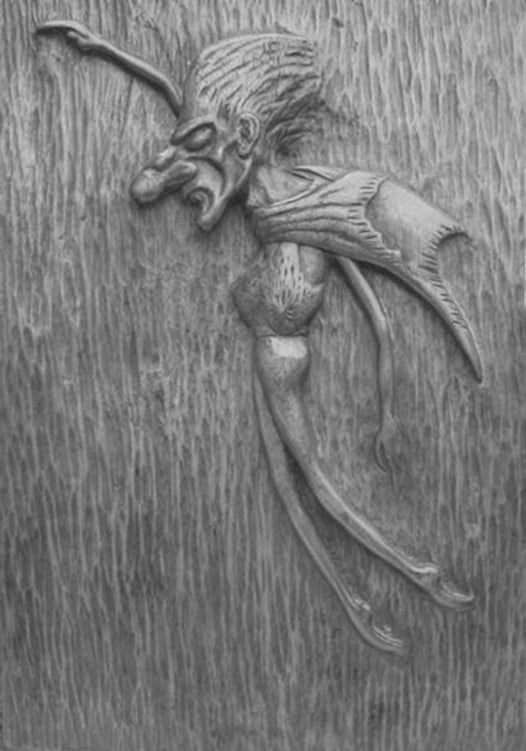
Legend tells, to become a witch, an individual must wash away baptism in a waterfall for forty days, assassinate a loved one, make a purse out of its skin in which to carry their book of spells and sign a pact with the devil with their own blood, stating when the evil one can claim their soul. Witches are capable of great mischief and can cause illness and death, even from afar.
According to the traveler Bruce Chatwin, who stumbled over traces of their story in the 1970s, they belonged to a “sect of male witches” that existed “for the purpose of hurting people.” According to their own statements, made during the trial of 1880, they ran protection rackets on the island, disposing of their enemies by poisoning or, worse, by sajaduras: magically inflicted “profound slashes.”
But since the same men also claimed to belong to a group called La Recta Provincia– a phrase that may be loosely translated as The Righteous Province – and styled themselves members of the Mayoria, the Majority, an alternative interpretation may also be advanced. Perhaps these witches were actually representatives of a strange sort of alternative government, an indigenous society that offered justice of Indians living under the rule of a white elite. Perhaps they were more shamans than sorcerers.
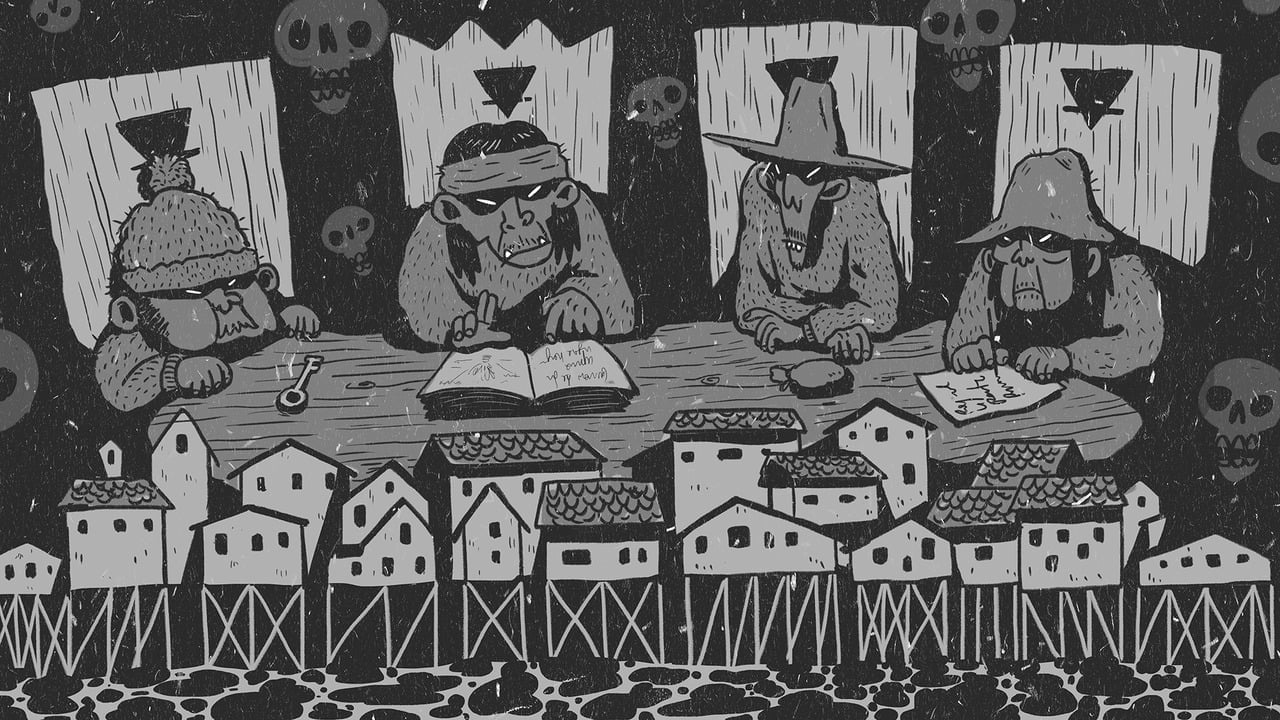
Instead of doctors, shamans prescribe herbal concoctions and perform rituals to cure simple afflictions. Instead of police, bodies of witches deal with everything from small disputes between neighbors to misbehaving animals.
Proceso a los brujos de Chiloé
The most important man of the Mayoria brought to court in 1880 was a Chilote farmer by the name of Mateo Coñuecar. He was then 70 years old, and by his own admission had been a member of the Righteous Province for more than two decades. According to Coñuecar’s testimony, the society was an important power on the island, with numerous members, an elaborate hierarchy of “kings” and “viceroys”- and a headquarters located in a vast cavern, whose secret entrance had been cleverly concealed in the side of a ravine.
The cavern was home to a pair of monsters that guarded the society’s most treasured possessions:
- an ancient leather book of magic and
- a bowl that, filled with water, allowed secrets to be seen.
Chivato and Invunche guarding the warlocks cave
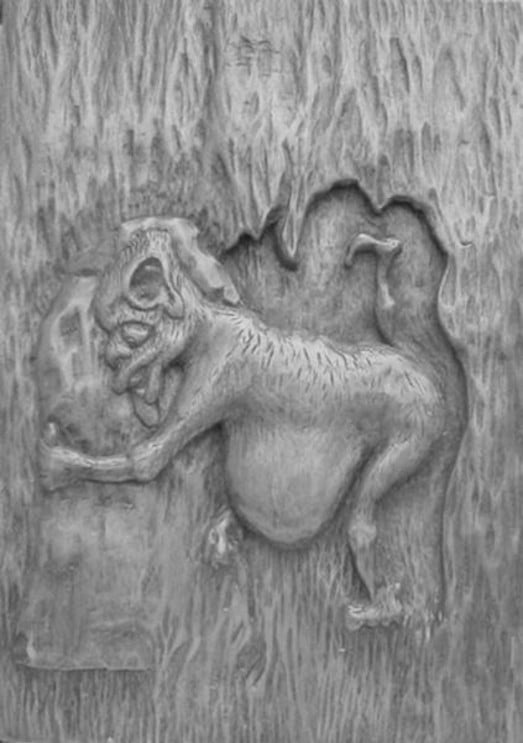
Their legendary cave, which Chilote tradition asserts was lit by torches burning human fat, is rumored to be near the village of Quicaví. The Chilean historian Benjamín Vicuña McKenna, includes this remarkable recollection of Mateo Coñuecars first visit to the cave:
Twenty years ago, when José Mariman was king, he was ordered to go to the cave with meat for some animals that lived inside. He complied with the order, and took them the meat of a kid he had slaughtered. Mariman went with him, and when they reached the cave, he started dancing about like a sorcerer, and quickly opened the entryway. This was covered over with a layer of earth (and grass to keep it hidden), and under this there was a piece of metal the ‘alchemy key.’ He used this to open the entryway, and was then faced with two completely disfigured beings which burst out of the gloom and rushed towards him. One looked like a goat, for it dragged itself along on four legs, and the other was a naked man, with a completely white beard and hair down to his waist.
The goat-like monster was the chivato, a deformed mute covered in piggish bristles.
How to “make” an Invunche
The other – and by far the more dangerous – of the cave’s twin denizens was the invunche or imbunche. Like the chivato, it had once been a human baby, and had been kidnapped in infancy. Chatwin describes what happened to the baby next:
When the Sect needs a new Invunche, the Council of the Cave orders a Member to steal a boy child from six months to a year old. The Deformer, a permanent resident of the Cave, starts work at once. He disjoints the arms and legs and the hands and feet. Then begins the delicate task of altering the position of the head. Day after day, and for hours at a stretch, he twists the head with a tourniquet until it has rotated through an angle of 180 degrees, that is until the child can look straight down the line of its own vertebrae.
There remains one last operation, for which another specialist is needed. At full moon, the child is laid on a work-bench, lashed down with its head covered in a bag. The specialist cuts a deep incision under the right shoulder blade. Into the hole he inserts the right arm and sews up the wound with thread taken from the neck of a ewe. When it has healed the Invunche is complete.
Naked, fed on human flesh- some say on goat meat, and confined below ground, neither the chivato nor the invunche received any sort of education; indeed it was said that neither ever acquired human speech in all the years they served what Chatwin calls the Committee of the Cave. Nevertheless, he concludes,
“over the years, does develop a working knowledge of the Committee’s procedure and can instruct novices with harsh and gutteral cries.”
The supernatural skills of the wizards
The members of the Righteous Province claimed, for example, to possess the ability to fly, using a special word- arrealhue- as they leapt into the air, and wearing a magical waistcoat, known as the macuñ, that gave them the power to defy gravity.
Each novice, when he joined the sect, was expected to fashion his own waistcoat; Chatwin reports that it was done by digging up and flaying a recently interred Christian corpse, though other sources say the waistcoat was made from the skin of a virgin girl or a dead sorcerer. Once dried and cured, the skin was sewn into a loose garment, and Chatwin adds the detail that “the human grease remaining in the skin gives off a soft phosphorescence, which lights the member’s nocturnal expeditions.”
Nor were the chivato and the invunche the only supernatural beings thought to be under the control of the Righteous Province.
The prisoners who testified in 1880 admitted under torture, that, on joining the society, each warlock was given a small, live lizard, which he wore strapped to his head with a bandana so that it was next to the skin. It was a magical creature from which the novice might imbibe all sorts of forbidden knowledge- not least how to transform himself into an animal and how to open locked doors.
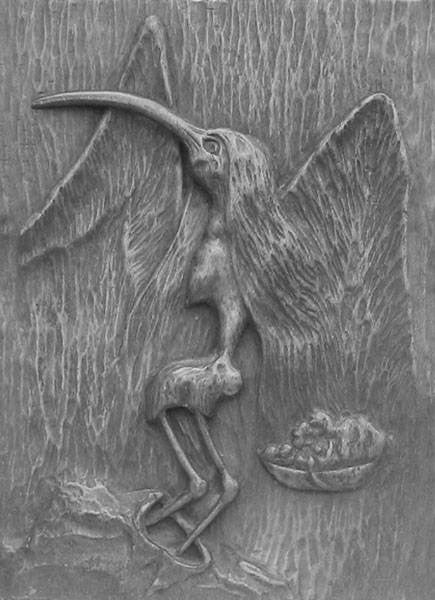
The Voladora
The warlocks messenger was the Voladora, a woman who transforms into a black bird by vomiting up her internal organs. The Voladora travels under the cover of night and can only be detected by her terrible cries, which bring bad luck. I have been told, that if the Voladora is unable to recover her innards at the end of the night, she is stuck in bird shape forever.
Part of the attraction of Chiloe is the wealth of mystery and legends and myths that permeate the misty, foggy reaches of forest and remote beaches, where at night you can see and hear a ghostly ship, the Caleuche.
THE CALEUCHE
‘The Sailor’, the ‘Ship of Fire’, the ‘Ship of Arts’, or simply ‘Barcoiche’, are some of the names given to this mysterious vessel of the Chilote waters.
Among the islanders, initiates were also believed to use seahorses to convey them to a magical vessel owned by the society and known as the Caleuche – a word that means “shapeshifter” in the local language.
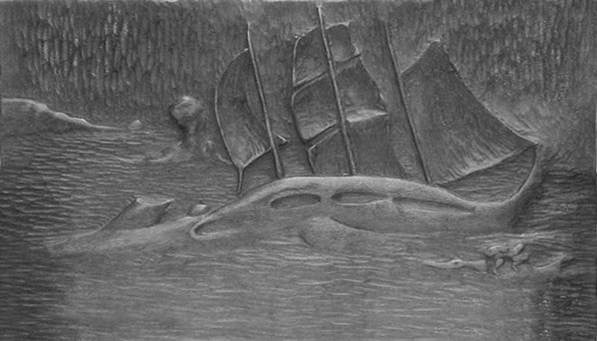
This ghostly ship glows in the fog, travels at great speeds both above and below the water, emitting beautiful music and carrying contraband cargoes carried for the island’s merchants, a trade that was one of the chief sources of the warlocks’ wealth. This tradition has outlived the warlocks of the Righteous Province, and even today, many Chilotes firmly believe that the Caleuche still haunts their coast, harvesting the souls of drowned sailors and fishermen who have perished at sea.
“Did you hear the music on the beach, at night … that’s actually inexplicable, that can not be…But, was there some light in the fog?”
One dark, mist-enshrouded night, there were noises heard in the distance. The receptionist explained it was the ghost ship Caleuche. He said it often sails in the fog and you can hear the music and rattling bones as its crew sings and dances drunkenly.
Descriptions of the Caleuche mention that it is a brig that sails, roams and appears – quite frequently – in the channels of the south. It can sail on the surface of the sea as well as under water; but it never does it in plain daylight. It usually appears at night, brightly lit with multicolored lights, and according to few witnesses, you can always hear music playing as in a never- ending party. However, it is always hidden behind a dense fog that the ship itself seems to create. Thus, Chilotes believe that the people who say they saw it, actually just ‘sensed’ it. This, because it is true that – from time to time – you can hear the sound of music and chains when you are navigating the channels of Chiloé in the middle of the night, but you cannot see anything there.
If by chance a person comes close to it, or if a person intentionally goes near it to look at the ship, the Caleuche has the power to turn into something else, such as a floating log, a rock, or any other inanimate object, and becomes invisible to the eye. The crew seems to have the same power, and they can turn into sea lions or birds. But if someone really wants to see it and doesn’t want to be spotted by the sailors of the Barcoiche, that person should put a sod in their mouth because the first thing they sense is the person’s breath. There are also some special trees you can hide behind, such as ‘maqui’ and ‘tique’ in order to achieve the same task.
Witnesses also mention that the crew is composed of two kinds of people:
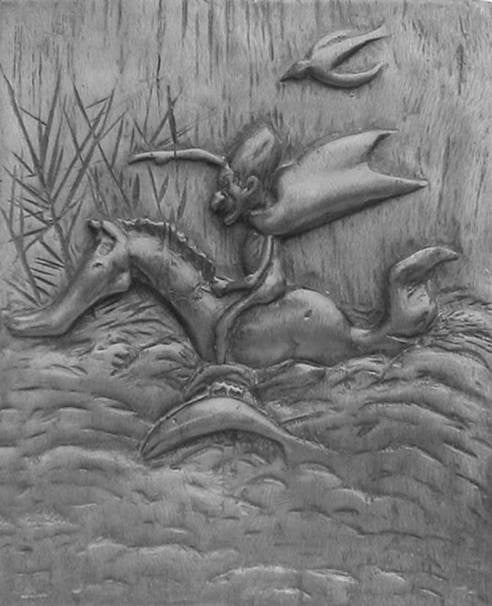
- the ‘wizards’, who board the ship from land carried by their ‘sea horses’;
- and the ‘castaways’, who were saved from the shipwrecks and upon touching the ship came to eternal and joyous life. This is one of the functions of the Caleuche: to help and pick up the dead after a ship has sunk or had an accident.
Once in a while, the crew of this Ship of Arts comes to land to have fun. They can do this in two ways: at the house of a Chilote friend, or at the house of an individual who was forced to throw a party as a punishment for his/her wrongdoings. In the first case, the sailors of Caleuche thank the friend with treasures as a reward. In the second case, however, the person is left poor and in misery. These cases explain why some Chilote people become rich so quickly, while others become poor in no time.
After the land parties – which are always full of food and other excesses – finish, the ‘Caleuchans’ happily return to their ship and weigh anchor, making the loud noise of chains that is heard in the darkest nights of Chiloé, and they continue with their eternal voyage along the shores of the island.
The people of the island were convinced of the existence of mythical creatures for such a long time depends on the isolation of Chiloé. The rough sea did not invite visitors. For more than 300 years, the Chilotes remained without contact with the mainland. Because of this isolation, the mentality of the 16th century could be maintained, the same as in the times of the Spaniards. Without contact with the outside world, the myths could continue to exist; and people look at them as something real.
Pablo Neruda’s words are still true:
“There is a big island: Chiloé, in the far South…
It’s wonderfully untouched, poor and full of human interest”
~ Nov. 13th, 1966.

~ ○ ~
Keep exploring:
Works Cited & Multimedia Sources
- https://www.memoriachilena.cl/archivos2/pdfs/MC0037759.pdf
- Dash Mike. Into the Cave of Chile’s Witches. Did members of a powerful society of warlocks actually murder their enemies and kidnap children? 2013. https://www.smithsonianmag.com/history/into-the-cave-of-chiles-witches-20138093/#MOOH3hkxWA7xls59.99
- Diccionario de la Brujería en Chiloé (Diccionario del léxico asociado a los brujos, con introducción y explicaciones históricas. Por Manuel Romo)
- Mitologia Chilota tallada en madera- Chiloé- all pictures from https://web.archive.org/web/20240704193622/https://chiloemitologico.cl/
- Myths and Legends from Chiloé. Un proyecto financiado por la Dirección de Vinculación con el Medio de la Universidad Austral de Chile. http://mandradey.wixsite.com/myths/our-story
- Rojas Flores Gonzalo. Reyes Sobre la Tierra: Brujeria y Chamanismo en Una Cultura Insular. Chiloe Entre Los Siglos XVIII y XX. http://www.memoriachilena.cl/archivos2/pdfs/MC0037759.pdf
- UNESCO World Heritage Centre. “Churches of Chiloé – UNESCO World Heritage Centre”. http://whc.unesco.org/en/list/971
